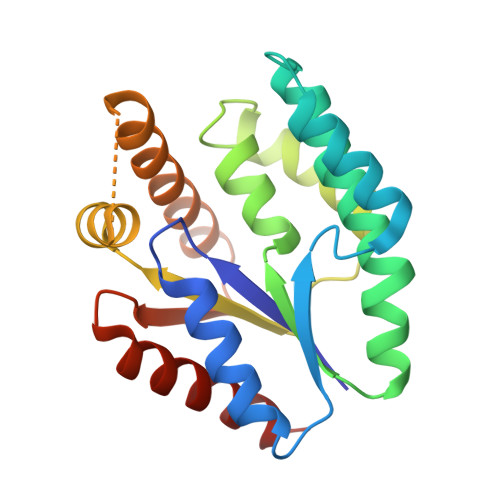Antibacterial inhibitors of gram-positive thymidylate kinase: structure-activity relationships and chiral preference of a new hydrophobic binding region.
Kawatkar, S.P., Keating, T.A., Olivier, N.B., Breen, J.N., Green, O.M., Guler, S.Y., Hentemann, M.F., Loch, J.T., McKenzie, A.R., Newman, J.V., Otterson, L.G., Martinez-Botella, G.(2014) J Med Chem 57: 4584-4597
- PubMed: 24828090
- DOI: https://doi.org/10.1021/jm500463c
- Primary Citation of Related Structures:
4QG7, 4QGA, 4QGF, 4QGG, 4QGH - PubMed Abstract:
Thymidylate kinase (TMK), an essential enzyme in bacterial DNA biosynthesis, is an attractive therapeutic target for the development of novel antibacterial agents, and we continue to explore TMK inhibitors with improved potency, protein binding, and pharmacokinetic potential. A structure-guided design approach was employed to exploit a previously unexplored region in Staphylococcus aureus TMK via novel interactions. These efforts produced compound 39, with 3 nM IC50 against S. aureus TMK and 2 μg/mL MIC against methicillin-resistant S. aureus (MRSA). This compound exhibits a striking inverted chiral preference for binding relative to earlier compounds and also has improved physical properties and pharmacokinetics over previously published compounds. An example of this new series was efficacious in a murine S. aureus infection model, suggesting that compounds like 39 are options for further work toward a new Gram-positive antibiotic by maintaining a balance of microbiological potency, low clearance, and low protein binding that can result in lower efficacious doses.
- Infection Innovative Medicines and ‡Discovery Sciences, AstraZeneca , 35 Gatehouse Drive, Waltham, Massachusetts 02451, United States.
Organizational Affiliation:

















